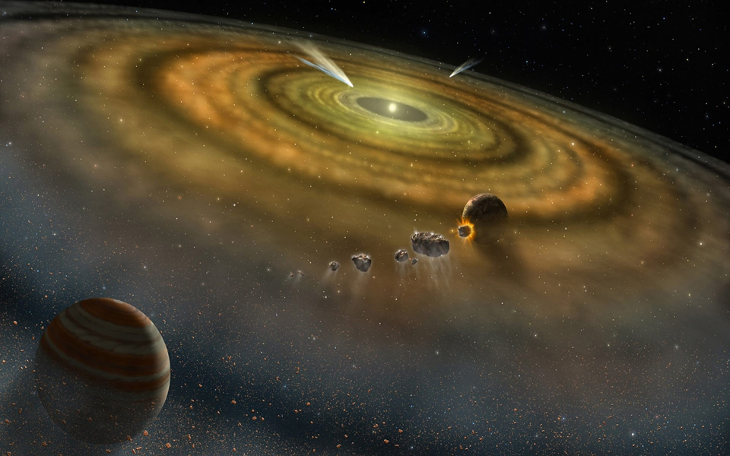At the heart of Jupiter is a rocky core, but how did this and other gas giant planets accumulate enough material to form their stony centres? New research of isotopes in meteorites suggest that Jupiter grew in three stages and while it did so, it kept sections of the early Solar System apart from one another for two million years.
It is understood that as would-be planets sweep around the dusty disk from which they form, they get bigger by picking up lots and lots of different sized rocks and pebbles that stick together until they reach a certain mass. But what sizes these solids are and how long it takes to mould together a planet’s core is still a major sticking point in planet formation theories.
When it comes to size, there seems to be two main types favoured; some scientists say that planets are built up through the accumulation of pebble sized solids, while others advocate planetesimal sized objects to grow massive cores.
Now, using state-of-the-art planet formation models to simulate Jupiter’s growth at its present location, a team of scientists whose lead author of the recently published work in Nature is Yann Alibert from Bern University, Switzerland, say it takes both, and that a time limit can be placed on each of the three stages it took Jupiter to reach its colossal size.
The analysis was aided by recent studies on isotopes of molybdenum, tungsten and platinum found in meteorites, which have inferred the existence of two reservoirs of small bodies in our early Solar System that were kept separated from one another by the very thing that would eventually eat up a lot of the disk; Jupiter.
Firstly, the formidable gas giant accumulated enough material in the shape of small pebble-sized solids to reach 20 Earth masses within one million years. This rapid accretion made up the major part of Jupiter’s core mass. Although it might seem impossible to build up a core of this size by sticking together billions upon billions of small pebble-sized rocks in such a relatively short space of time, the team say that pebble accretion is so efficient that objects can quickly become more massive than Jupiter providing accretion has started long before the proto-planetary disk disperses.
Then, in the next two million years it more than doubled its mass to 50 Earth masses by swallowing up small planet-sized balls of material.
The constant grazing of planetesimals to gain 30 Earth masses in two million years not only kept the two reservoirs of small bodies apart, but also had a knock-on effect of slowing down the gas accretion process.
Once the gas giant grew to 50 Earth masses however, it quickly bulked up on gas and sent material flying in to the inner regions of the Solar System as it reconnected the two bodies with its staggering proportions; to put Jupiter’s size into prospective (its core and surrounding gas), its current day mass is one-thousandth that of the Sun, or to put it another way, two-and-a-half times that of all the other planets in the Solar System combined.
The results from this analysis say the team, suggest that a substantial mass of small planetesimals (that are kilometres in size) was present in the solar nebula at one million years and that these smaller objects would be the smashed up remnants of large primordial planetesimals that were obliterated following a collision with a planet twice as big as Earth.
Finally, explain the team, as their new hybrid pebble–planetesimal scenario allows for a proto-planet to build up mass (between a range of 15-50 Earth masses) over a few million years before rapid gas accretion takes place, then intermediate mass planets such as Uranus and Neptune can be naturally accounted for.











